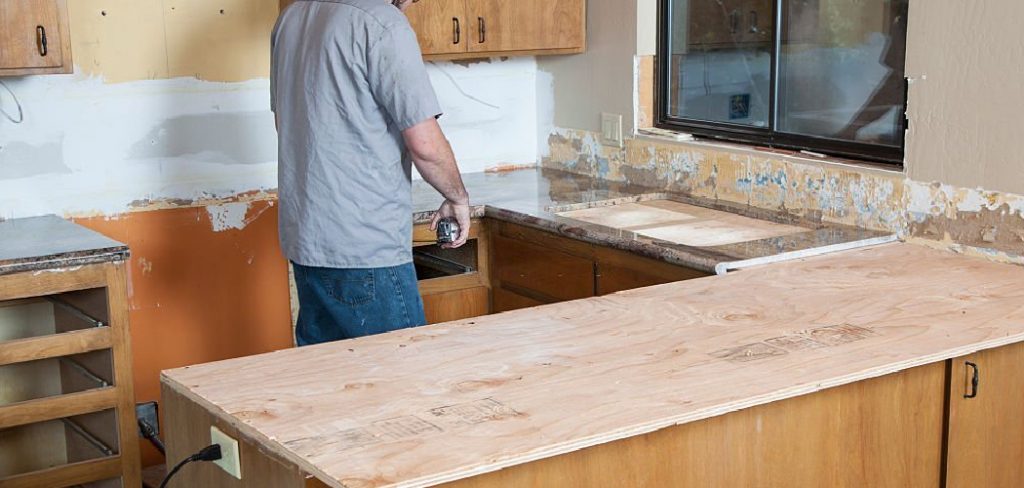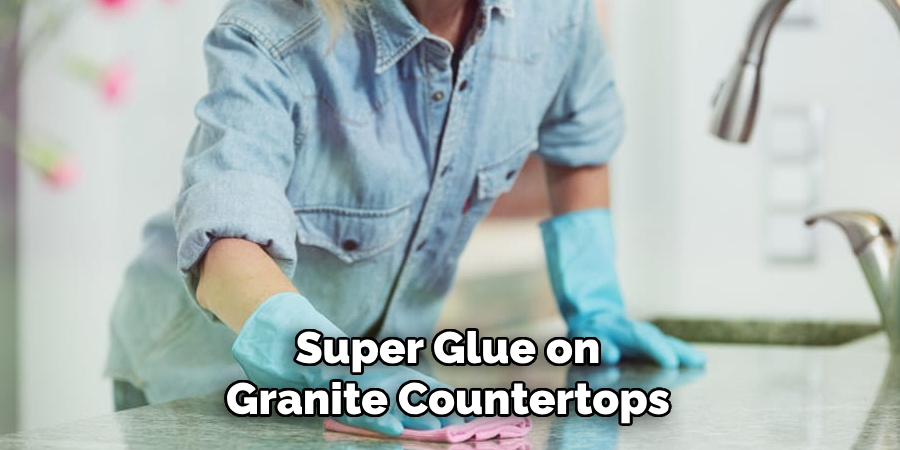Removing super glue from a granite countertop can seem like a daunting task, but with the right approach, it’s entirely manageable. Granite is a durable and beautiful natural stone, but it requires careful handling to avoid damage.
When dealing with stubborn adhesives like super glue, it’s important to use methods and materials that are effective yet gentle enough to preserve the stone’s surface and finish. This guide will provide step-by-step instructions on how to get super glue off granite countertop.

Why Granite Requires Careful Cleaning to Avoid Damage
Granite is a porous natural stone that, while resilient, can be susceptible to staining, discoloration, and surface degradation if exposed to harsh chemicals or abrasive tools. Its polished finish can lose its luster when cleaned with improper materials such as acidic cleaners or strong solvents, which may etch or dull the surface.
Additionally, the pores of granite can trap residues if not cleaned properly, leading to long-term damage. For this reason, it’s crucial to use gentle, non-abrasive methods and pH-neutral cleaners to maintain the integrity and appearance of the stone. Proper care ensures durability and keeps granite looking its best for years to come.
Understanding Granite’s Sensitivity
Granite’s sensitivity to certain substances and cleaning methods stems from its composition and structure. Though it is a hard and durable stone, its surface can still be vulnerable to scratches, etching, and stains if not handled carefully.
Substances like acidic liquids, such as vinegar or lemon juice, can weaken the finish and cause dull spots, while abrasive scrubbing materials may leave scratches. Granite’s natural pores can also absorb liquids or chemicals, causing discoloration or weakening its sealant over time.
Recognizing these sensitivities is key to selecting appropriate cleaning products and techniques to safeguard your countertop’s appearance and longevity. With the right approach, granite can retain its beauty and functionality for decades.
10 Methods How to Get Super Glue off Granite Countertop
1. Wipe Away Fresh Glue Immediately with Warm Soapy Water
If the super glue has just spilled onto your granite countertop and hasn’t dried yet, your best chance of removing it is to act quickly. Use warm water mixed with a few drops of mild dish soap and a soft microfiber cloth to wipe the glue away before it hardens.
Avoid using abrasive scrubbing pads, as they can dull the granite’s polished surface. If the glue has started to set, soak the cloth in warm soapy water and lay it over the glue for a few minutes to loosen it before wiping it off. This simple method is safe for sealed granite and works best when the glue hasn’t fully cured.

2. Use Acetone for Stubborn Glue Residue
Acetone is a powerful solvent that can effectively break down super glue without harming sealed granite. Dampen a cotton ball or soft cloth with acetone (or nail polish remover containing acetone) and gently dab it onto the glue. Let it sit for a minute or two to soften the adhesive.
Once the glue starts to break apart, use a plastic scraper or an old credit card to lift it off the surface. Wipe the area clean with warm soapy water afterward to remove any remaining acetone residue. While acetone is generally safe for granite, prolonged exposure can dry out the sealant, so it’s best to use it sparingly and rinse the area thoroughly.
3. Apply Rubbing Alcohol to Dissolve the Glue
Rubbing alcohol (isopropyl alcohol) is another effective way to remove super glue without damaging granite. Soak a cotton ball in rubbing alcohol and apply it to the affected area. Let it sit for about five minutes to weaken the bond of the glue. Afterward, gently scrape the softened glue away using a plastic scraper.
Rinse the countertop with warm water and dry it with a clean cloth. Rubbing alcohol is a milder alternative to acetone and is less likely to affect the granite’s sealant, making it a safer choice for regular use.
4. Loosen the Glue with Olive Oil or Coconut Oil
If you prefer a natural approach, olive oil or coconut oil can help loosen dried super glue without using harsh chemicals. Apply a generous amount of oil to the glue and let it sit for 15–20 minutes.
The oil will penetrate the glue, making it easier to peel off. Use a soft cloth or a plastic scraper to gently lift the adhesive. Afterward, wipe the area clean with warm, soapy water to remove any oil residue. This method is particularly useful for those who want to avoid chemical solvents and is gentle on granite countertops.
5. Use a Razor Blade Carefully for Thick Glue Layers
If a thick layer of super glue has dried onto your granite countertop, a razor blade can be used to carefully lift it off. Hold the blade at a very shallow angle and gently scrape the glue, being cautious not to scratch the surface.

For best results, combine this method with acetone or rubbing alcohol to soften the glue before attempting to scrape it. Always use light pressure and move the blade in small, controlled motions to avoid damaging the polished finish of the granite.
6. Try a Baking Soda and Water Paste for Gentle Scrubbing
A mild abrasive like baking soda can help break down super glue without scratching granite. Mix baking soda with a small amount of water to create a thick paste. Apply the paste to the glue stain and let it sit for about 10 minutes.
Then, use a soft cloth to rub the area in a circular motion. This method is gentle enough to use on granite while providing a mild scrubbing action to lift the glue. Afterward, rinse with warm water and dry with a microfiber cloth.
7. Use a Commercial Granite-Safe Adhesive Remover
There are commercial adhesive removers specifically designed for use on stone surfaces like granite. These products are formulated to break down glue without damaging the stone or its sealant.
Follow the manufacturer’s instructions, usually involving applying the product, letting it sit, and wiping away the softened glue. Always choose a granite-safe formula and test a small, inconspicuous area first to ensure it doesn’t affect the color or finish of your countertop.
8. Apply a Warm Vinegar Soak (Use with Caution!)
While vinegar is acidic and not typically recommended for granite, it can be used cautiously for small super glue stains if properly diluted. Mix one part white vinegar with three parts warm water and soak a cloth in the solution.
Place the cloth over the glue stain for about 10 minutes, then gently wipe the glue away. Immediately rinse the area with warm, soapy water and dry it thoroughly to prevent prolonged exposure to acidity, which can weaken the granite’s sealant. This method is best for small, minor stains rather than large glue spills.
9. Use a Soft Scrub Pad for Gentle Mechanical Removal
If the glue is still present after trying other methods, a soft scrub pad (such as a non-scratch kitchen sponge) can help remove any remaining residue. Lightly dampen the pad with warm, soapy water or rubbing alcohol and scrub in gentle, circular motions.
Avoid using steel wool or highly abrasive scrubbers, as they can scratch the surface. This method works best in combination with other glue-softening techniques like oil or acetone.

10. Prevent Future Glue Mishaps with a Protective Barrier
Once you’ve successfully removed the super glue, it’s important to prevent future accidents by taking precautions when working with adhesives. If you anticipate using super glue near your granite countertops, cover the surface with a protective barrier such as wax paper, plastic wrap, or a silicone mat. Additionally, resealing your granite countertops annually can help maintain their resistance to stains and chemical exposure, making future cleanups easier.
Maintenance and Upkeep
Proper maintenance and regular upkeep are essential to preserve the beauty and durability of granite countertops. Start by cleaning your countertops daily with a gentle cleanser, such as a mixture of warm water and mild dish soap, applied with a soft cloth or sponge. Avoid harsh chemicals, abrasive pads, or acidic cleaners like vinegar and lemon juice, as these can degrade the sealant over time.
Reseal your granite countertops annually or as recommended by the manufacturer to maintain their protective layer. Conduct a simple water test by placing a few drops on the surface; if the water soaks in within minutes, it’s time to reseal.
Additionally, avoid exposing granite to extreme heat or heavy impacts, which can cause cracks or chips. Use trivets or heat-resistant mats under hot cookware and cutting boards to prevent scratches. With diligent care, your granite countertops can remain exquisite and functional for years to come.

Conclusion
Super glue on granite countertops can be frustrating, but with the right techniques, it can be safely removed without causing damage. Whether using solvents like acetone and rubbing alcohol, natural solutions like olive oil and baking soda, or mechanical methods like razor blades and scrub pads, there is a method suited to every situation.
Always test new cleaning solutions on an inconspicuous area first and rinse thoroughly after treatment. Thanks for reading our blog post on how to get super glue off granite countertop! We hope you found it helpful and informative.
Professional Focus
Angela Ervin, a former interior designer turned blogger, specializes in kitchen design and renovations. Through her website, she blends her passion for cooking with design expertise, sharing practical and creative ideas. Known for balancing functionality and beauty, Angela’s insightful content has made her a trusted voice in home design and lifestyle.
About the Author
Angela Ervin, an experienced interior designer and blogger, combines her passion for kitchen renovations with storytelling. Living in Petersburg with her family, she enjoys cooking and testing her projects firsthand. Known for her humor and relatable style, Angela shares creative, functional design insights through her content, making her a trusted voice in home design.
Education History
University: Virginia Commonwealth University
Degree: Bachelor of Fine Arts (BFA) in Interior Design
- Angela’s education at VCU focused on mastering core interior design principles, including spatial planning, color theory, materials selection, and sustainable design practices.
- She gained hands-on experience through studio projects and collaborative design exercises, which honed her ability to create functional and aesthetically pleasing environments.
- Her coursework also emphasized problem-solving and practical applications of design, preparing her for real-world projects like her self-directed kitchen renovations.
- The program’s strong foundation in both technical skills and creative expression shaped Angela’s ability to seamlessly integrate form and function in her work.
